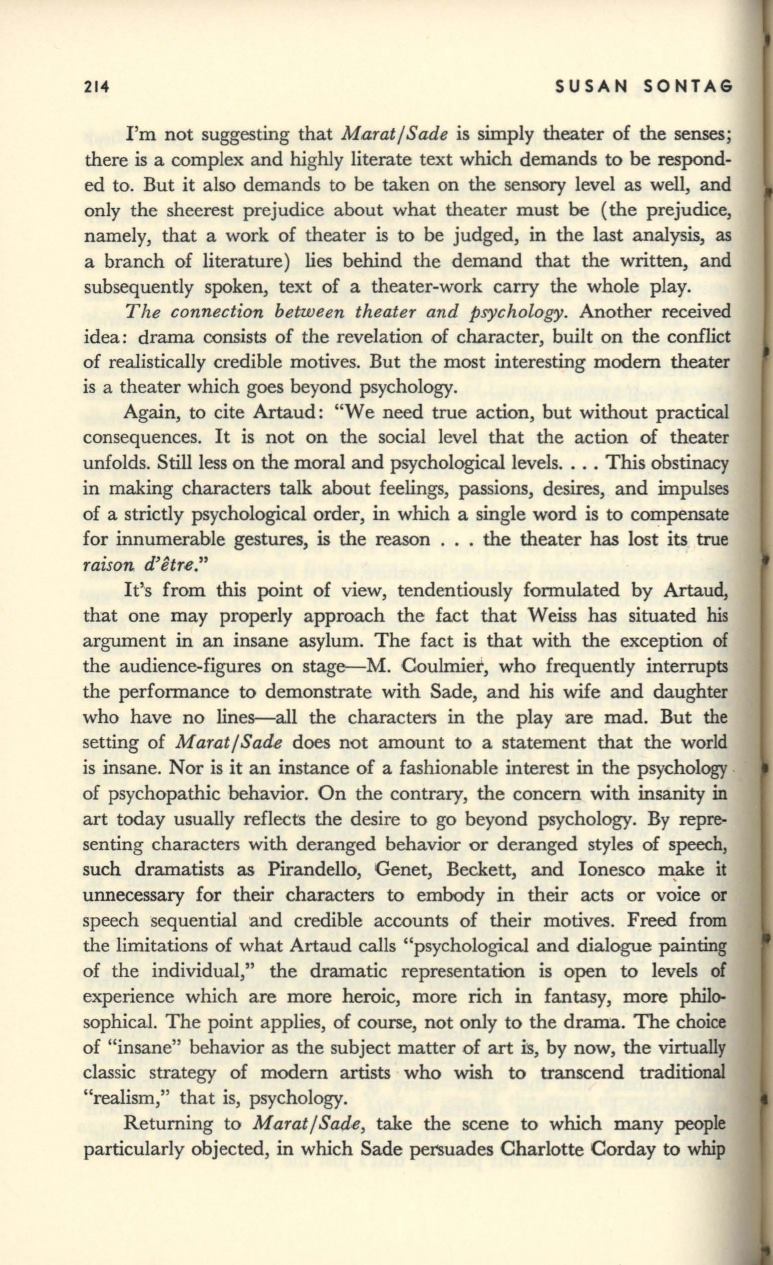
214
SUSAN SONTAG
I'm not suggesting that
Marat/Sade
is simply theater of the senses;
there is a complex and highly literate text which demands to be respond–
ed to. But it also demands to be taken on the sensory level as well, and
only the sheerest prejudice about what theater must
be
(the prejudice,
namely, that a work of theater
is
to be judged,
in
the last analysis, as
a branch of literature) lies behind the demand that the written, and
subsequently spoken, text of a theater-work carry the whole play.
The connection between theater and psychology.
Another received
idea: drama consists of the revelation of character, built on the conflict
of realistically credible motives. But the most interesting modern theater
is a theater which goes beyond psychology.
Again, to cite Artaud: "We need true action, but without practical
consequences. It is not on the social level that the action of theater
unfolds. Still less on the moral and psychological levels.... This obstinacy
in making characters talk about feelings, passions, desires, and impulses
of a strictly psychological order, in which a single word is to compensate
for innumerable gestures,
is
the reason . . . the theater has lost its true
raison d'etre."
If's from this point of view, tendentiously formulated by Artaud,
that one may properly approach the fact that Weiss has situated his
argument
in
an insane asylum. The fact is that with the exception of
the audience-figures on stage-M. Coulmiet, who frequently interrupts
the performance to demonstrate with Sade, and his wife and daughter
who have no lines-all the characters
in
the play are mad. But the
setting of
Marat/Sade
does not amount to a statement that the world
is insane. Nor is it an instance of a fashionable interest in the psychology
of psychopathic behavior. On the contrary, the concern with insanity
in
art today usually reflects the desire to go beyond psychology. By repre–
senting characters with deranged behavior or deranged styles of speech,
such dramatists as Pirandello, Genet, Beckett, and Ionesco m,ake
it
unnecessary for their characters to embody in their acts or voice or
speech sequential and credible accounts of their motives. Freed from
the limitations of what Artaud calls "psychological and dialogue painting
of the individual," the dramatic representation is open to levels of
experience which are more heroic, more rich in fantasy, more philo–
sophical. The point applies, of course, not only to the drama. The choice
of "insane" behavior as the subject matter of art is, by now, the virtually
classic strategy of modern artists who wish to transcend traditional
"realism," that is, psychology.
Returning to
Marat/Sad,e,
take the scene to which many people
particularly objected, in which Sade persuades Charlotte Corday to whip


